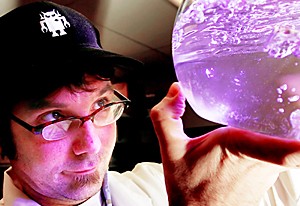The Amazing Spider-Man may be science fiction, but a UA scientist’s discovery of a genetic link between spiders and bacteria is grounded in scientific fact.
Matt Cordes, an assistant professor in biochemistry and molecular biophysics, and Greta Binford, a biology professor at Lewis and Clark College, have proved certain brown spiders and bacteria share a common toxin.
Cordes and Binford’s research proves a lateral gene transfer (LGT) between spiders of the genus Loxosceles, which include the brown recluse, and a strain of bacteria known to cause illnesses in farm animals.
The toxin in question is a component of spider venom that can cause necrotic skin lesions and is only found in the spiders and the pathogenic Corynebacteria, according to Cordes and Binford’s findings.
The research shows that two organisms, even with different cellular make-up, can feed off each other’s attributes to survive, Cordes said.
“”The big lesson is nature will tend to reuse what it already has for different purposes rather than reinvent the wheel,”” Cordes said.
The findings of the research are also important because they can be used to develop a molecule that will block out the harmful toxin, Cordes said.
As for the field of genetic research, taking attributes from one animal and putting them in another is still many years away, Cordes said
An LGT occurs when two organisms of a different species share bits of DNA, which is then passed to the next generation, said Howard Ochman, a professor of biochemistry and molecular biology.
A vertical gene transfer is more common and occurs when two parents of the same species produce an offspring that shares the DNA of the parents, Ochman said.
Lateral gene transfers are common among bacteria, but rare between bacteria and eukaryotes, or organisms with complex cells such as plants, animals and fungi, Ochman said.
Cordes said it is unknown which direction the transfer originally occurred because both the spider and bacteria have a narrow ancestry. Normally during LGT, the organism with the wider ancestry is the original transferor.
Binford said a spider-to-bacteria transfer is more likely because the bacteria’s cells do not have a protective membrane around them as found in spider cells.
Cordes said there are many theories as to how this gene transfer occurred.
“”When you have a transfer like this, it
usually suggests some kind of contact between the species,”” Cordes said.
A fly carrying the bacteria could’ve been consumed by the spider or the spider could’ve bitten a mammal infected with the bacteria, Cordes said.
“”The most important thing is we can imagine scenarios that can happen,”” Binford said.
Two years were spent trying to understand the relationship between the two organisms, but the actual analysis only took a few weeks, Binford said.
Cordes said his background in proteins and Binford’s background in spiders helped make this discovery.
“”She and I saw an opportunity to put our heads together to solve a problem that neither one of us could’ve,”” Cordes said.









